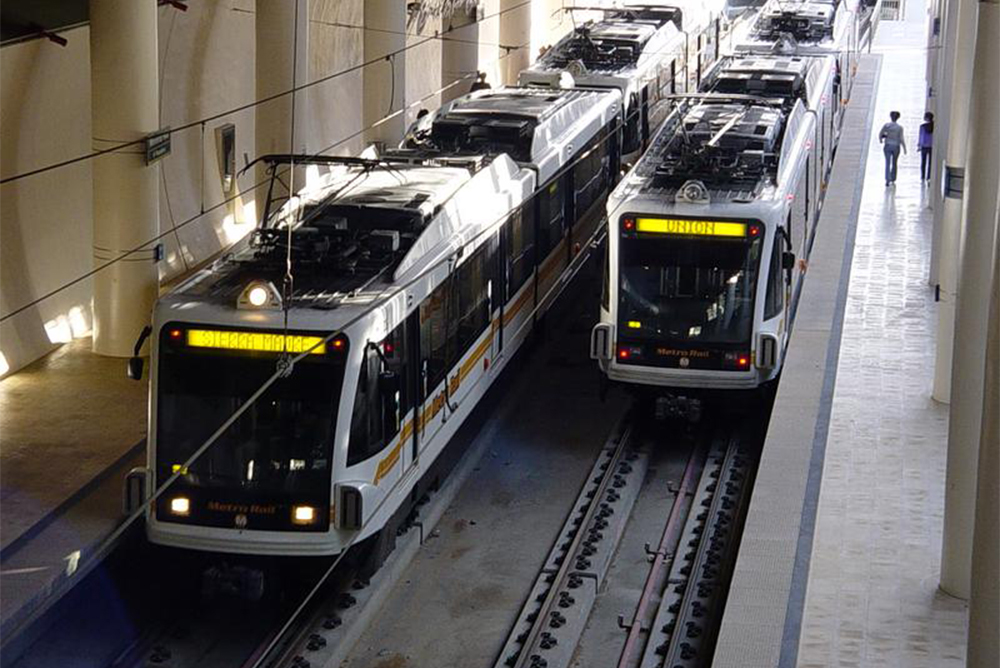
Years in the making, the $1.7 billion L.A. Regional Connector will link the city’s light rail lines into one integrated system. As it debuts on June 16, columnist Joe Mathews wonders: Will it bring about a new transformation in California life? Or does it arrive too late? Courtesy of Wikimedia Commons.
What will the Regional Connector bring us? A new transformation in California life? Or has it arrived too late to change much of anything?
The June 16 opening of a two-mile rail tunnel under downtown Los Angeles might not seem like a big deal. But its potential—and its timing—mark a pivotal moment for the future of transportation.
L.A. is opening the smartest and most significant piece of its 21st-century Metro rail system at a moment of maximum peril for public transit, both nationally and statewide. The pandemic, along with work-from-home policies and fears of crime, cratered ridership on systems from BART to the San Diego MTS. Local trains and buses across California are often dirty, broken, and filled with unhoused people.
Now, at the height of the state budget season, Gov. Gavin Newsom and the legislature are preparing to address a $30 billion deficit by cutting more than $2 billion for transit infrastructure —which could be crippling for financially struggling transit systems.
As a result, the opening of the Regional Connector risks becoming a sort of triumph worthy of Emily Dickinson, who wrote, “Victory comes late / And is held low to freezing lips … How sweet it would have tasted.”
Please forgive poetry in a column on transportation politics, but I feel wistful as I think of all the people and places to which the Regional Connector might have connected me, had it been built decades ago. It was first envisioned in the 1980s, seriously studied in the 1990s, and planned in the 2000s.
The $1.7 billion Regional Connector’s purpose is right there in its name: It connects the L.A. region’s separate light-rail lines into one integrated system. In the process, the connector creates a north-south line, running from Azusa through downtown and all the way to Long Beach. It also creates an east-west line, from East L.A. to Santa Monica. And it adds three new underground stations along its downtown path.
Oh, how I wish the Regional Connector had been finished in the 2010s, when I worked in Santa Monica, and spent two hours on trains to commute from the San Gabriel Valley. It would have been marvelous in the 2000s, back when I worked at the L.A. Times downtown—the connector’s new Historic Broadway station is across the street from the old Times building, which no longer houses the Times. And I would have loved to have taken the new long, north-south line from home down to Long Beach to visit my aunt and my cousins on my father’s side. But they are all dead, or have moved elsewhere.
Transit delayed is transit denied. If L.A. hadn’t spent the second half of the 20th century dithering on transit, instead of building, we’d be better connected now. Indeed, transit investment would have given L.A. some ballast to help it withstand the economic retrenchment of the 1990s and the population stagnation since; it might even have prevented the shrinking and aging we’re experiencing now. More transit would have cemented connections, fostering new developments, new businesses, new housing, new friendships, new families.
The Regional Connector will arrive too late—unless we change our defeatist mindset, this toxic idea that wealthy California can’t transform itself. I hope its new, integrated rail lines bring many more people downtown and to other places throughout the city. I hope they become the favored way for people in East L.A. to travel to West Side jobs and beaches. I hope they draw travelers and ambitious young people here. I hope they pull us away from our screens and out of our apartments and houses, to see each other again. (I’m writing this late on a Sunday afternoon, in a nearly empty Grand Park downtown.)
This summer, I wish every Californian would read Henry George’s once-famous 1868 essay about California’s future, “What the Railroad Will Bring Us,” in which he contemplated how the state might take advantage of the coming arrival of a much larger regional connector, the transcontinental railroad.
George wrote at a time when, as now, California seemed stuck. Life was too expensive; people were giving up. But he counseled against pessimism. The state was struggling but not stuck. Indeed, its problems demonstrated its potential.
“For years,” George wrote, “the high rate of interest and the high rate of wages prevailing in California have been special subjects for the lamentation of a certain school of local political economists, who could not see that high wages and high interest were indications that the natural wealth of the country was not yet monopolized, that great opportunities were open to all.”
George was right that California’s best days lay ahead. Let’s try to recapture his spirit now. If we all get on board, if we all open new connections, maybe L.A. and California can relocate their true selves. And we can grow again.




Send A Letter To the Editors